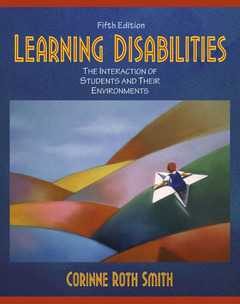Description
Learning disabilities (5th ed )
Authors: SMITH Corinne, WEIL Marsha
Language: English
Approximative price 111.43 €
Subject to availability at the publisher.
Add to cart
Publication date: 09-2003
608 p. · Hardback
608 p. · Hardback
Contents
/li>
Each chapter concludes with 'Summary' and 'Helpful Resources.'
Preface.
Educational Philosophy and Practices.Advocacy.Research and Program Development.2. Definition, Identification, and Prevalence.
Definition.Identification Practices.Prevalence of Learning Disabilities.
Neuropsychological Patterns of Learning.Brain Injury.Structural Brain Differences.Hereditary Factors.Biochemical Irregularities and Attention Deficit Hyperactivity Disorder.4. Curricular and Environmental Contributors.
Curriculum Contributors.Family and School Environment Contributors.Implications for Assessment and Intervention.5. Information-Processing Patterns in Learning Disabilities.
Visual-Perceptual Skills.Language and Phonological Processing Skills.Attention.Motor Skills.Implications for Assessment and Intervention.
The Elementary School Years.The Middle and High School Years.The Adult Years.7. Learning Strategy and Information-Processing Development.
Attention, Memory, and Learning Strategies.Visual-Perceptual, Motor, and Language Development.8. Social-Emotional Development.
The Preschooler.The Elementary School Student.The Secondary School Student.The Adult.
Assessment Purposes.Models of Assessment.Assessment Methods.Multidimensional Assessment Approaches.Assessment Domains.10. Planning Educational Interventions.
Planning Individualized Instruction.Adapting Instruction to the Student's Abilities and Learning Style.Defining and Coordinating Intervention Roles.11. Instructional Strategies: The Preschool and Elementary School Years.
Preschool Programming.Elementary School Programming.12. Instructional Strategies: The Middle and Secondary School Years.
Reading.Written Language.Mathematics.Study and Test-Taking Skills.Transition Planning.Social-Emotional Adjustment.
Families and Learning.Family Assessment.Family Adjustment to a Learning Disability.Family Intervention.14. The School.
Physical Characteristics.Organizational Characteristics.Human Characteristics.References.
Subject Index.
Preface.
I. THE CONCEPT OF LEARNING DISABILITIES.
1. History of the Field.Educational Philosophy and Practices.Advocacy.Research and Program Development.2. Definition, Identification, and Prevalence.
Definition.Identification Practices.Prevalence of Learning Disabilities.
II. CAUSES OF LEARNING DISABILITIES.
3. Physiological Differences.Neuropsychological Patterns of Learning.Brain Injury.Structural Brain Differences.Hereditary Factors.Biochemical Irregularities and Attention Deficit Hyperactivity Disorder.4. Curricular and Environmental Contributors.
Curriculum Contributors.Family and School Environment Contributors.Implications for Assessment and Intervention.5. Information-Processing Patterns in Learning Disabilities.
Visual-Perceptual Skills.Language and Phonological Processing Skills.Attention.Motor Skills.Implications for Assessment and Intervention.
III. THE STUDENT.
6. Academic Development.The Elementary School Years.The Middle and High School Years.The Adult Years.7. Learning Strategy and Information-Processing Development.
Attention, Memory, and Learning Strategies.Visual-Perceptual, Motor, and Language Development.8. Social-Emotional Development.
The Preschooler.The Elementary School Student.The Secondary School Student.The Adult.
IV. THE CURRICULUM.
9. Assessment.Assessment Purposes.Models of Assessment.Assessment Methods.Multidimensional Assessment Approaches.Assessment Domains.10. Planning Educational Interventions.
Planning Individualized Instruction.Adapting Instruction to the Student's Abilities and Learning Style.Defining and Coordinating Intervention Roles.11. Instructional Strategies: The Preschool and Elementary School Years.
Preschool Programming.Elementary School Programming.12. Instructional Strategies: The Middle and Secondary School Years.
Reading.Written Language.Mathematics.Study and Test-Taking Skills.Transition Planning.Social-Emotional Adjustment.
V. THE ENVIRONMENT.
13. The Family.Families and Learning.Family Assessment.Family Adjustment to a Learning Disability.Family Intervention.14. The School.
Physical Characteristics.Organizational Characteristics.Human Characteristics.References.
Subject Index.
© 2024 LAVOISIER S.A.S.




